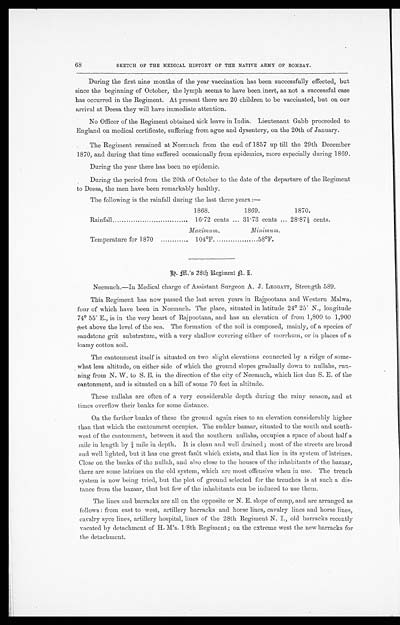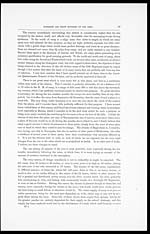Medicine - Institutions > Army health reports and medical documents > Sketch of the medical history of the native army of Bombay > Sketch of the medical history of the native army of Bombay, for the year 1870
(20) Page 68
Download files
Individual page:
Thumbnail gallery: Grid view | List view

68
SKETCH OF THE MEDICAL HISTORY OF THE NATIVE ARMY OF BOMBAY.
During the first nine months of the year vaccination has been successfully effected, but
since the beginning of October, the lymph seems to have been inert, as not a successful case
has occurred in the Regiment. At present there are 20 children to be vaccinated, but on our
arrival at Deesa they will have immediate attention.
No Officer of the Regiment obtained sick leave in India. Lieutenant Gabb proceeded to
England on medical certificate, suffering from ague and dysentery, on the 20th of January.
The Regiment remained at Neemuch from the end of 1857 up till the 29th December
1870, and during that time suffered occasionally from epidemics, more especially during 1869.
During the year there has been no epidemic.
During the period from the 20th of October to the date of the departure of the Regiment
to Deesa, the men have been remarkably healthy.
The following is the rainfall during the last three years:—
| 1868. | 1869. | 1870. | |
| Rainfall | 16.72 cents | 31.73 cents | 28.87½ cents. |
| Maximum. | Minimum.. | ||
| Temperature for 1870 | 104°F | 58°F. |
h. m.'s 28th Regiment n.i.
Neemuch.—In Medical charge of Assistant Surgeon A. J. LEGGATT, Strength 589.
This Regiment has now passed the last seven years in Rajpootana and Western Malwa,
four of which have been in Neemuch. The place, situated in latitude 24° 25' N., longitude
74° 55' E., is in the very heart of Rajpootana, and has au elevation of from 1,800 to 1,900
feet above the level of the sea. The formation of the soil is composed, mainly, of a species of
sandstone grit substratum, with a very shallow covering either of morrhum, or in places of a
loamy cotton soil.
The cantonment itself is situated on two slight elevations connected by a ridge of some-
what less altitude, on either side of which the ground slopes gradually down to nullahs, run-
ning from N. W. to S. E. in the direction of the city of Neemuch, which lies due S. E. of the
cantonment, and is situated on a hill of some 70 feet in altitude.
These nullahs are often of a very considerable depth during the rainy season, and at
times overflow their banks for some distance.
On the farther banks of these the ground again rises to an elevation considerably higher
than that which the cantonment occupies. The sudder bazaar, situated to the south and south-
west of the cantonment, between it and the southern nullahs, occupies a space of about half a
mile in length by ¼ mile in depth. It is clean and well drained; most of the streets are broad
and well lighted, but it has one great fault which exists, and that lies in its system of latrines.
Close on the banks of the nullah, and also close to the houses of the inhabitants of the bazaar,
there are some latrines on the old system, which are most offensive when in use. The trench
system is now being tried, but the plot of ground selected for the trenches is at such a dis-
tance from the bazaar, that but few of the inhabitants can be induced to use them.
The lines and barracks are all on the opposite or N. E. slope of camp, and are arranged as
follows: from east to west, artillery barracks and horse lines, cavalry lines and horse lines,
cavalry syce lines, artillery hospital, lines of the 28th Regiment N. I., old barracks recently
vacated by detachment of H. M's. 1/8th Regiment; on the extreme west the new barracks for
the detachment.
Set display mode to: Large image | Zoom image | Transcription
Images and transcriptions on this page, including medium image downloads, may be used under the Creative Commons Attribution 4.0 International Licence unless otherwise stated. ![]()
| Permanent URL | https://digital.nls.uk/75007173 |
|---|




